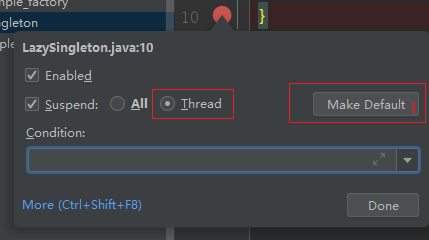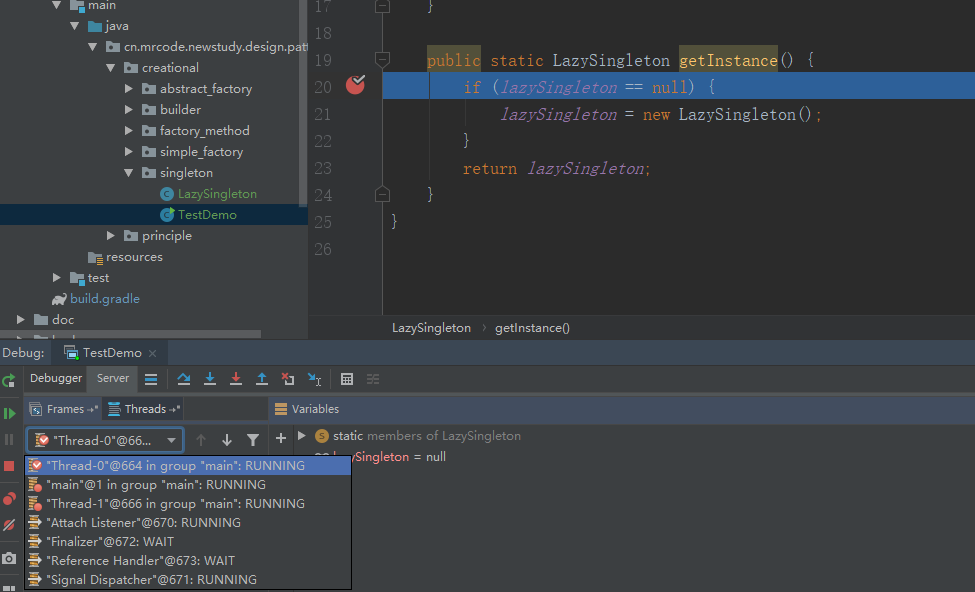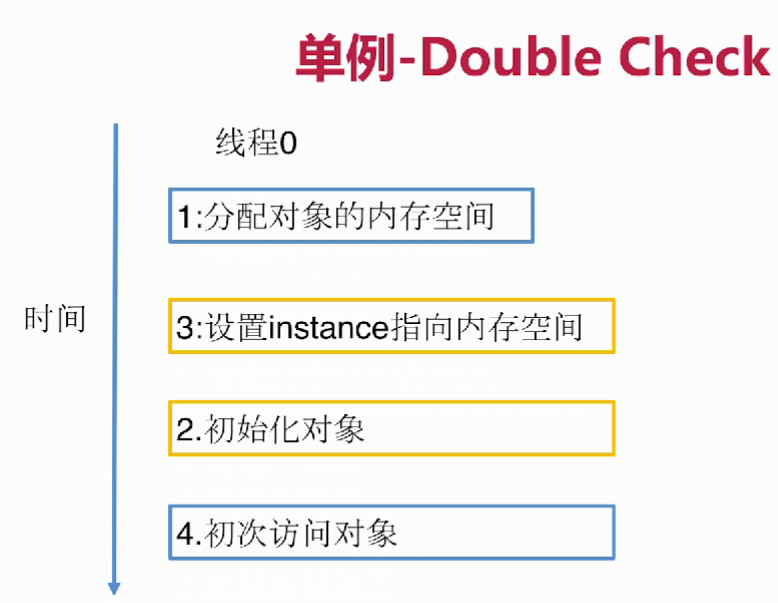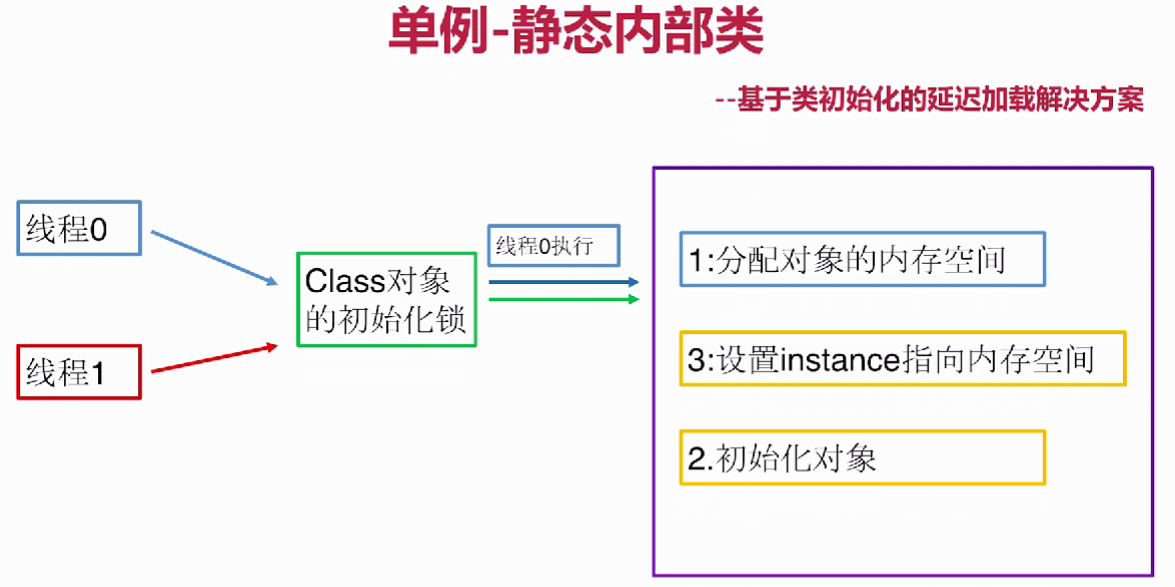# 单例模式
关联阅读 李兴华-单例模式
这一节的内容李兴华老师的课程就略显干货不足了。
定义:保证一个类仅有一个实例,并提供一个全局访问点
类型:创建型
# 适用场景
想确保任何情况下都绝对只有一个实例
# 优缺点
优点:
- 在内存里只有一个实例,减少了内存开销
- 可以避免对资源的多重占用
- 设置全局访问点,严格控制访问
缺点:
- 没有接口,扩展困难
# 重点
- 私有构造器:防止在外部创建对象
- 线程安全
- 延迟加载:使用的时候才创建
- 序列化和反序列化安全
- 反射:防止反射攻击
# 实用技能
- 反编译
- 内存原理
- 多线程 Debug
# 相关的设计模式
- 单例模式和工厂模式
- 单例模式和享元模式
# coding
# 懒汉式单例模式
线程不安全的懒汉式单例模式比较简单,两个要点:
- 私有构造
- 内部持有一个实例,在访问的时候再初始化
cn.mrcode.newstudy.design.pattern.creational.singleton.LazySingleton
public class LazySingleton {
private static LazySingleton lazySingleton = null;
private LazySingleton() {
}
public static LazySingleton getInstance() {
if (lazySingleton == null) {
lazySingleton = new LazySingleton();
}
return lazySingleton;
}
}
2
3
4
5
6
7
8
9
10
11
12
13
14
15
public class TestDemo {
public static void main(String[] args) {
// LazySingleton instance = LazySingleton.getInstance();
// System.out.println(instance);
// 使用多线程来 演示 debug 怎么调试
new Thread(() -> LazySingleton.getInstance()).start();
new Thread(() -> LazySingleton.getInstance()).start();
System.out.println("done");
}
}
2
3
4
5
6
7
8
9
10
11
# 多线程 debug 教程

先打上断点,然后在断点上右键,即可出现上图中的内容;选择 thread 方式,并设置为默认

看上图,因为现在在 main 线程中,使用 debug 停留了。
切换到 线程0 中,可以看到一直阻塞在这里的。这样一来多线程调试就更方便了

# 懒汉式 - synchronized
保证线程安全最简单的就是加 synchronized 关键字;
public synchronized static LazySingleton getInstance() {
if (lazySingleton == null) {
lazySingleton = new LazySingleton();
}
return lazySingleton;
}
2
3
4
5
6
但是这样会有一个问题,就是每个线程获取都会被阻塞。如果在一个很繁忙的系统中,这里的性能就大大降低了。
可以使用双重检查来优化这个地方,实际上就是减少锁的粒度
public class LazyDoubleCheckSingleton {
private static LazyDoubleCheckSingleton lazyDoubleCheckSingleton = null;
private LazyDoubleCheckSingleton() {
}
public static LazyDoubleCheckSingleton getInstance() {
// 第一层不加锁,有值则返回
if (lazyDoubleCheckSingleton == null) {
// 假设有2个线程进入到这里在等待了
synchronized (LazyDoubleCheckSingleton.class) {
// 那么当第一个线程创建之后,其实是有值的了
// 所以这里还需要判定一下,有值则不创建了
// 所以这里是双重判定
if (lazyDoubleCheckSingleton == null) {
lazyDoubleCheckSingleton = new LazyDoubleCheckSingleton();
// 这里有一个内存可见性的问题
// 上面这一句话其实分为三步
// 1. 分配内存给这个对象
// 2. 初始化对象
// 3. 设置 lazyDoubleCheckSingleton 指向刚分配的内存
}
}
}
return lazyDoubleCheckSingleton;
}
}
2
3
4
5
6
7
8
9
10
11
12
13
14
15
16
17
18
19
20
21
22
23
24
25
26
27
对于这个内存可见性的问题。步骤 2 和步骤 3 可能被重排序。在多线程情况下,如果被重排序了
那么在第一层判断的时候就会判断有值,但是实际上对象还未被初始化。
?:我怎么记忆中是这里初始化了,因为内存可见性,其他线程会认为看不到已经改变
也就是下图中描述的情况;


要解决这个问题:
- volatile 变量:
对于一个 volatile 域的写,happens-before 于任意后续对这个 volatile 的读 但是,不保证写是原子的; 所以:这里使用 volatile 只是保证一个线程的写对另一个线程可见,加上 synchronized 保证写操作是原子的。在 synchronized 域中可重排序。但是在释放锁的时候,保证结果正确
- 禁止重排序:使用内部类,让 jvm 来保证两个操作直接的禁止重排
保证 lazyDoubleCheckSingleton 的可见性;给该变量加上 volatile 关键字即可;
volatile :会让其他 cpu 中缓存的数据失效,读取主存中的数据。即可保证内存对其他线程课件
# 懒汉式 - 内部类
public class StaticInnerClassSingleton {
private static class InnerClass {
private static StaticInnerClassSingleton instance = new StaticInnerClassSingleton();
}
public static StaticInnerClassSingleton getInstance() {
return InnerClass.instance;
}
}
2
3
4
5
6
7
8
9
静态内部类很简单。下面代码来测试是否是延迟的情况
public class StaticInnerClassSingleton {
{
System.out.println("单例类初始化");
}
private static class InnerClass {
static {
System.out.println("内部类初始化");
}
private static StaticInnerClassSingleton instance = new StaticInnerClassSingleton();
}
public static void print() {
System.out.println("测试是否是延迟初始化的");
}
public static StaticInnerClassSingleton getInstance() {
return InnerClass.instance;
}
}
2
3
4
5
6
7
8
9
10
11
12
13
14
15
16
17
18
19
20
21
执行测试代码
StaticInnerClassSingleton instance = StaticInnerClassSingleton.getInstance();
输出:
内部类初始化
单例类初始化
2
3
4
5
6
执行测试代码
StaticInnerClassSingleton.print();
输出
测试是否是延迟初始化的
2
3
4
5
可以看到,只有在使用该实例的时候,才会被初始化,而这个初始化时 jvm 保证线程安全性的;
原理是:

在类初始化的时候 jvm 会获取一个初始化锁,保证多个线程对同一个对象的初始化安全问题
这里有一个遗留问题:上面的代码中。没有对单例类私有构造。一定要加深认识
# 饿汉式
public class HungrySingleton {
private final static HungrySingleton hungrySingleton = new HungrySingleton();
private HungrySingleton() {
}
public static HungrySingleton getInstance() {
return hungrySingleton;
}
}
2
3
4
5
6
7
8
9
10
在类加载的时候完成赋值;
在之前差不多把单例模式修补得比较完善了,现在来破坏单例模式。
# 破坏单例模式
使用序列化,再反序列化,那么这个对象还是之前的那个对象吗?
@Test
public void test() throws IOException, ClassNotFoundException {
HungrySingleton instance = HungrySingleton.getInstance();
// 序列化到文件
ObjectOutputStream oos = new ObjectOutputStream(new FileOutputStream("HungrySingleton"));
oos.writeObject(instance);
// 从文件读取出来
ObjectInputStream ois = new ObjectInputStream(new FileInputStream("HungrySingleton"));
HungrySingleton instanceFromFile = (HungrySingleton) ois.readObject();
System.out.println(instance);
System.out.println(instanceFromFile);
System.out.println(instance == instanceFromFile);
}
2
3
4
5
6
7
8
9
10
11
12
13
14
15
16
17
18
输出
cn.mrcode.newstudy.design.pattern.creational.singleton.HungrySingleton@7494e528
cn.mrcode.newstudy.design.pattern.creational.singleton.HungrySingleton@7d0587f1
false
2
3
那么怎么破解这个问题呢?很简单在单例类中增加一个方法
private Object readResolve() {
return hungrySingleton;
}
2
3
原理是什么呢?这个要看源码
java.io.ObjectInputStream#readObject
java.io.ObjectInputStream#readObject0
case TC_OBJECT:
return checkResolve(readOrdinaryObject(unshared));
找到这一行。继续跟踪
private Object readOrdinaryObject(boolean unshared)
throws IOException
{
if (bin.readByte() != TC_OBJECT) {
throw new InternalError();
}
ObjectStreamClass desc = readClassDesc(false);
desc.checkDeserialize();
Class<?> cl = desc.forClass();
if (cl == String.class || cl == Class.class
|| cl == ObjectStreamClass.class) {
throw new InvalidClassException("invalid class descriptor");
}
Object obj;
try {
// 首先先通过反射创建实例
// 当实现了 serializable/externalizable 接口的时候,则返回 true
obj = desc.isInstantiable() ? desc.newInstance() : null;
} catch (Exception ex) {
throw (IOException) new InvalidClassException(
desc.forClass().getName(),
"unable to create instance").initCause(ex);
}
passHandle = handles.assign(unshared ? unsharedMarker : obj);
ClassNotFoundException resolveEx = desc.getResolveException();
if (resolveEx != null) {
handles.markException(passHandle, resolveEx);
}
if (desc.isExternalizable()) {
readExternalData((Externalizable) obj, desc);
} else {
readSerialData(obj, desc);
}
handles.finish(passHandle);
// 这里再判定 是否有读解析方法
if (obj != null &&
handles.lookupException(passHandle) == null &&
desc.hasReadResolveMethod())
{
Object rep = desc.invokeReadResolve(obj);
if (unshared && rep.getClass().isArray()) {
rep = cloneArray(rep);
}
if (rep != obj) {
handles.setObject(passHandle, obj = rep);
}
}
return obj;
}
// 这里判定这个方法是否存在
// 也就是说,如果你中的类中定义了 readResolve 方法,那么将会调用该方法
// 也就是不允许外部实例化
// 这里一定要看注释,英文的也要认证翻译看。不然光看这个代码,是看不出来什么的
boolean hasReadResolveMethod() {
return (readResolveMethod != null);
}
/** class-defined readResolve method, or null if none */
private Method readResolveMethod;
// 可以搜索下这个变量在哪里赋值的,这里就可以看到了,定义了这么一个字符串,去查找这个方法
readResolveMethod = getInheritableMethod(
cl, "readResolve", null, Object.class);
2
3
4
5
6
7
8
9
10
11
12
13
14
15
16
17
18
19
20
21
22
23
24
25
26
27
28
29
30
31
32
33
34
35
36
37
38
39
40
41
42
43
44
45
46
47
48
49
50
51
52
53
54
55
56
57
58
59
60
61
62
63
64
65
66
67
68
69
70
71
72
73
74
75
76
77
78
79
# 反射攻击解决方案及原理分析
# 类加载就初始化的单例模式
针对恶汉单例模式来测试,使用反射和正常获取实例的对比是否是同一个实例。
@Test
public void test2() throws NoSuchMethodException, IllegalAccessException, InvocationTargetException, InstantiationException {
Class<HungrySingleton> objectClass = HungrySingleton.class;
Constructor<HungrySingleton> constructor = objectClass.getDeclaredConstructor();
HungrySingleton instance = HungrySingleton.getInstance();
// java.lang.IllegalAccessException: Class cn.mrcode.newstudy.design.pattern.creational.singleton.HungrySingletonTest can not access a member of class cn.mrcode.newstudy.design.pattern.creational.singleton.HungrySingleton with modifiers "private"
// 解决私有构造不能访问的限制
constructor.setAccessible(true);
HungrySingleton objectInstance = constructor.newInstance();
System.out.println(instance);
System.out.println(objectInstance);
System.out.println(instance == objectInstance);
}
2
3
4
5
6
7
8
9
10
11
12
13
14
15
结果很明显,不是同一个。原因:
- final static 修饰的是在类加载的时候完成的初始化
- 这里反射是调用空参构造
所以这里出来的不是同一个对象。那么这里的防御攻击就很简单了。
// 在私有构造中判定一下即可
private HungrySingleton() {
if (hungrySingleton != null) {
throw new IllegalStateException("单例模式不允许使用反射创建");
}
}
2
3
4
5
6
# 懒汉式防御解析
首先,结论是,懒汉式没有办法防御反射攻击。原因:使用的时候才会初始化,没有办法保证只初始化一次。
public class LazySingleton {
private static LazySingleton lazySingleton = null;
private LazySingleton() {
}
public synchronized static LazySingleton getInstance() {
if (lazySingleton == null) {
lazySingleton = new LazySingleton();
}
return lazySingleton;
}
}
2
3
4
5
6
7
8
9
10
11
12
13
14
这里使用前面恶汉式的方式来演示之后就明白了。
private LazySingleton() {
if (lazySingleton != null) {
throw new IllegalStateException("单例模式不允许使用反射创建");
}
}
2
3
4
5
测试代码
@Test
public void test4() throws NoSuchMethodException, IllegalAccessException, InvocationTargetException, InstantiationException {
LazySingleton instance = LazySingleton.getInstance();
System.out.println(instance);
Class<LazySingleton> lazySingletonClass = LazySingleton.class;
Constructor<LazySingleton> declaredConstructor = lazySingletonClass.getDeclaredConstructor();
declaredConstructor.setAccessible(true);
LazySingleton lazySingleton = declaredConstructor.newInstance();
System.out.println(lazySingleton);
System.out.println(instance == lazySingleton);
}
2
3
4
5
6
7
8
9
10
11
12
现在这个测试代码是可以防御到的,因为先运行了 LazySingleton.getInstance(), 但是吧他们的顺序改变下,就不能防御了,或者是在多线程程序中也是不能防御的。
问题根源就在于:如果先用反射创建,那么变量没有赋值。
所以这里可以增加一个状态,来记录是否可以创建对象。当然这里只能限制只被执行一次
private static boolean flag = true;
private LazySingleton() {
if (flag) {
// 构造只能被调用一次
flag = false;
} else {
throw new IllegalStateException("单例模式不允许使用反射创建");
}
}
2
3
4
5
6
7
8
9
10
测试代码可以使用上一次的,这里演示为什么说添加变量的方式也没有办法阻止。 因为变量也是成员,也可以通过反射的方式修改。下面演示
@Test
public void test5() throws NoSuchMethodException, IllegalAccessException, InvocationTargetException, InstantiationException, NoSuchFieldException {
LazySingleton instance = LazySingleton.getInstance();
System.out.println(instance);
Class<LazySingleton> lazySingletonClass = LazySingleton.class;
// 只是增加了这一段代码,把标志变量修改了
Field flag = lazySingletonClass.getDeclaredField("flag");
flag.setAccessible(true);
flag.set(instance, true);
Constructor<LazySingleton> declaredConstructor = lazySingletonClass.getDeclaredConstructor();
declaredConstructor.setAccessible(true);
LazySingleton lazySingleton = declaredConstructor.newInstance();
System.out.println(lazySingleton);
System.out.println(instance == lazySingleton);
}
2
3
4
5
6
7
8
9
10
11
12
13
14
15
16
17
18
通过实验得知:懒汉式的无法防止反射攻击。因为它不是类加载的时候被初始化,无法保证初始化顺序
# 枚举单例模式
public enum EnumInstance {
INSTANCE;
private Object data;
public static EnumInstance getInstance() {
return INSTANCE;
}
public Object getData() {
return data;
}
public void setData(Object data) {
this.data = data;
}
}
2
3
4
5
6
7
8
9
10
11
12
13
14
15
16
17
18
# 枚举单例模式序列化攻击测试
@Test
public void test6() throws IOException, ClassNotFoundException {
EnumInstance instance = EnumInstance.getInstance();
instance.setData(new Date());
// 序列化到文件
ObjectOutputStream oos = new ObjectOutputStream(new FileOutputStream("EnumInstance"));
oos.writeObject(instance);
// 从文件读取出来
ObjectInputStream ois = new ObjectInputStream(new FileInputStream("EnumInstance"));
EnumInstance instanceFromFile = (EnumInstance) ois.readObject();
System.out.println(instance);
System.out.println(instanceFromFile);
System.out.println(instance == instanceFromFile);
System.out.println("===== 查看实例里面的 变量是否是同一个");
System.out.println(instance.getData());
System.out.println(instanceFromFile.getData());
System.out.println(instance.getData() == instanceFromFile.getData());
}
2
3
4
5
6
7
8
9
10
11
12
13
14
15
16
17
18
19
20
21
22
这个是为什么呢? 源码会告诉我们答案
java.io.ObjectInputStream#readObject 入口
找到读取枚举的地方
case TC_ENUM:
return checkResolve(readEnum(unshared));
java.io.ObjectInputStream#readEnum
Enum<?> result = null;
Class<?> cl = desc.forClass();
if (cl != null) {
try {
@SuppressWarnings("unchecked")
// 直接通过名称和class获取的
Enum<?> en = Enum.valueOf((Class)cl, name);
result = en;
} catch (IllegalArgumentException ex) {
throw (IOException) new InvalidObjectException(
"enum constant " + name + " does not exist in " +
cl).initCause(ex);
}
if (!unshared) {
handles.setObject(enumHandle, result);
}
}
2
3
4
5
6
7
8
9
10
11
12
13
14
15
16
17
18
19
20
21
22
23
24
25
# 枚举反射攻击测试
// 枚举反射攻击
@Test
public void test7() throws NoSuchMethodException, IllegalAccessException, InvocationTargetException, InstantiationException {
EnumInstance instance = EnumInstance.getInstance();
System.out.println(instance);
Class<EnumInstance> enumInstanceClass = EnumInstance.class;
Constructor<EnumInstance> declaredConstructor = enumInstanceClass.getDeclaredConstructor();
declaredConstructor.setAccessible(true);
EnumInstance enumInstance = declaredConstructor.newInstance();
System.out.println(enumInstance);
System.out.println(instance == enumInstance);
}
2
3
4
5
6
7
8
9
10
11
12
13
14
运行发现,找不到无参构造,这是怎么回事呢?
java.lang.NoSuchMethodException: cn.mrcode.newstudy.design.pattern.creational.singleton.EnumInstance.<init>()
at java.lang.Class.getConstructor0(Class.java:3082)
at java.lang.Class.getDeclaredConstructor(Class.java:2178)
at cn.mrcode.newstudy.design.pattern.creational.singleton.SingletonTest.test7(SingletonTest.java:135)
2
3
4
5
# 反编译 - jad 查看 class 文件
需要看下编译后的 class 文件,idea 自带的可以查看,但是我发现并没有编译后的任何迹象,不知道是为什么。
那么使用 http://jd.benow.ca/ (jd-gui) 来查看编译后的 class 文件。会发现和 idea 中查看到的文件内容一模一样
https://varaneckas.com/jad/ 使用该 jad ,是一个命令行工具。Windows 版本解压后,就是一个 jad.exe ,配置好环境变量。找到 idea 生成的 class 文件。运行以下命令
jad EnumInstance.class
就会生成 EnumInstance.jad 文件。使用记事本等文本编辑器打开即可查看
在 Windows10 中配置了环境变量,暂时未生效,只能暂时进入该软件的目录中运行了
2
3
4
生成的文件内容如下
// Decompiled by Jad v1.5.8g. Copyright 2001 Pavel Kouznetsov.
// Jad home page: http://www.kpdus.com/jad.html
// Decompiler options: packimports(3)
// Source File Name: EnumInstance.java
package cn.mrcode.newstudy.design.pattern.creational.singleton;
public final class EnumInstance extends Enum
{
public static EnumInstance[] values()
{
return (EnumInstance[])$VALUES.clone();
}
public static EnumInstance valueOf(String name)
{
return (EnumInstance)Enum.valueOf(cn/mrcode/newstudy/design/pattern/creational/singleton/EnumInstance, name);
}
private EnumInstance(String s, int i)
{
super(s, i);
}
public static EnumInstance getInstance()
{
return INSTANCE;
}
public Object getData()
{
return data;
}
public void setData(Object data)
{
this.data = data;
}
public static final EnumInstance INSTANCE;
private Object data;
private static final EnumInstance $VALUES[];
static
{
INSTANCE = new EnumInstance("INSTANCE", 0);
$VALUES = (new EnumInstance[] {
INSTANCE
});
}
}
2
3
4
5
6
7
8
9
10
11
12
13
14
15
16
17
18
19
20
21
22
23
24
25
26
27
28
29
30
31
32
33
34
35
36
37
38
39
40
41
42
43
44
45
46
47
48
49
50
51
52
53
54
通过以上内容可以总结出:
- INSTANCE 变量是 static final 修饰的
private EnumInstance(String s, int i)私有化的参数构造方法- 使用静态代码块来构造枚举对象实例
这里就真相了,反射的时候使用无参构造,报错找不到方法。
# 枚举单例模式续
那么这里使用有参的继续下去;
@Test
public void test7() throws NoSuchMethodException, IllegalAccessException, InvocationTargetException, InstantiationException {
EnumInstance instance = EnumInstance.getInstance();
System.out.println(instance);
Class<EnumInstance> enumInstanceClass = EnumInstance.class;
Constructor<EnumInstance> declaredConstructor = enumInstanceClass.getDeclaredConstructor(String.class,int.class);
declaredConstructor.setAccessible(true);
// 这里还是根据 jad 里面的内容来传参数
EnumInstance enumInstance = declaredConstructor.newInstance("INSTANCE", 0);
System.out.println(enumInstance);
System.out.println(instance == enumInstance);
}
2
3
4
5
6
7
8
9
10
11
12
13
14
结果发现还是不行,报错信息明确的说明了 不能通过反射创建枚举对象
java.lang.IllegalArgumentException: Cannot reflectively create enum objects
at java.lang.reflect.Constructor.newInstance(Constructor.java:416)
at cn.mrcode.newstudy.design.pattern.creational.singleton.SingletonTest.test7(SingletonTest.java:137)
2
3
4
跟源码
public T newInstance(Object ... initargs)
throws InstantiationException, IllegalAccessException,
IllegalArgumentException, InvocationTargetException
{
if (!override) {
if (!Reflection.quickCheckMemberAccess(clazz, modifiers)) {
Class<?> caller = Reflection.getCallerClass();
checkAccess(caller, clazz, null, modifiers);
}
}
// 进行了检查,枚举类型直接异常了
if ((clazz.getModifiers() & Modifier.ENUM) != 0)
throw new IllegalArgumentException("Cannot reflectively create enum objects");
2
3
4
5
6
7
8
9
10
11
12
13
# 枚举类小结
- INSTANCE 变量是 static final 修饰的
private EnumInstance(String s, int i)私有化的参数构造方法- 使用静态代码块来构造枚举对象实例
- 序列化和反序列化是由序列化相关的类保证的
- 反射攻击是由反射相关类保证的,而它自己不保证这些
由于本文篇幅很大了,下一章节继续